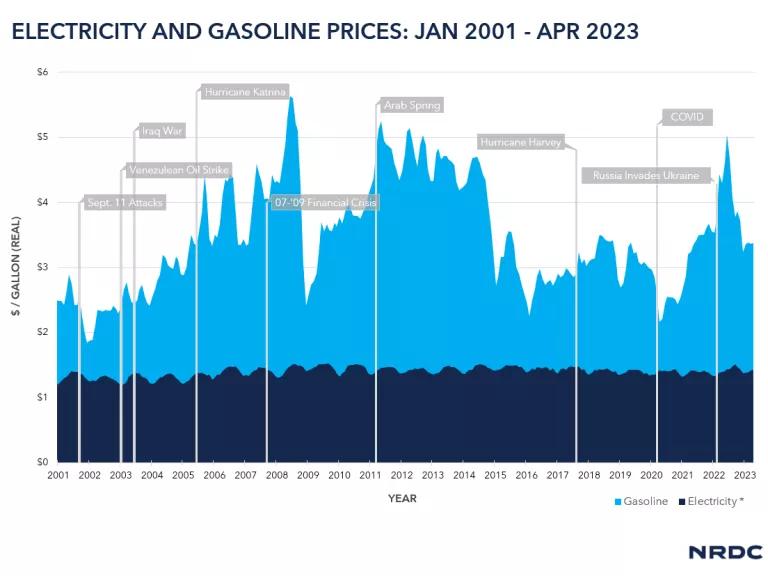Electric Vehicles: A Win-Win for Illinois Drivers & Utility Customers
Widespread adoption of electric vehicles in Illinois will benefit all utility customers as we transition towards a cleaner transportation system.

Electric meters
Robert So/Pexels
Electric vehicles are one of the best ways individuals can cut their carbon emissions. New analysis shows that they are also a great way to cut costs. In Illinois, EVs are the cheapest way to drive and actually save all Illinois utility customers money on their electric bills.
Electrifying transportation is a key part of achieving our climate goals and addressing the largest source of carbon pollution in the state. Illinois must adopt clean vehicle standards like the Advanced Clean Trucks (ACT) and Advanced Clean Cars II (ACC II) rules to facilitate the transition towards a cleaner transportation system. With these standards in place, the number of EVs on the road will increase, providing significant health and economic benefits without burdening our utility customers with extra costs. In Illinois we’ve seen this in action, where EVs are already bringing costs down for the average Illinois utility customer.
Electric Vehicles–A Cheaper Way to Get Around.
In the past, the sticker price of a gas-powered vehicle was a lot lower than that of an EV. This trend is rapidly changing, as the price gap between gas-powered cars and EVs narrows. When you factor in federal tax credits, the up-front costs are already nearly identical. That being said, where EVs really outshine gas-powered cars is when you compare the total lifetime costs of vehicle ownership.
EVs provide significant cost saving opportunities for owners over the long term. One factor that contributes to this is how stable electricity costs are compared to the highly volatile price of gas and diesel fuel. Recently, owners of gas-powered cars have had to deal with dramatic spikes in gas prices, but even without accounting for the recent volatility, the average cost to fuel an electric car was around $485 a year, compared to $1,117 for a gas-powered car. Other studies display even greater savings, with EV drivers shown to spend about 60 percent less each year on fuel costs compared to gas-powered cars.

*Shown in $/“eGallon” or the cost of fueling a vehicle with electricity compared to a similar vehicle that runs on gasoline. Data source: Energy Information Administration, January 2023; monthly averages. (June 27, 2023: This chart was updated to include electricity and gasoline prices for early 2023.)
Maintenance also factors into EV-related savings. EVs have significantly fewer moving parts, making them easier and cheaper to maintain. EVs don’t need oil changes and don’t have complex transmissions or hydraulic braking systems to service or upgrade. Taking a look at an EV motor makes this fact strikingly evident: EV motors generally have two moving parts whereas the average combustion motor has forty. Switching to an EV is a choice that materially saves vehicle owners both time and money.
Electric Vehicles–A Tool to Drive Down Electricity Costs.
In addition to the individual savings, EVs end up saving all electricity customers on their bills. There is a widespread misconception that as EV charging increases, the electric grid will inevitably be strained, triggering the need for costly upgrades. However, the reality is the opposite. The time of day when you use electricity is an important factor that determines grid impacts and the costs associated with delivering that electricity. The fact is, people tend to charge their EVs overnight, when most people are asleep, and the demand for electricity is low. Accommodating extra electricity use at this time, including EV charging, only results in small marginal costs to the system.
Real-world data was evaluated in a study by Synapse Energy Economics to reveal how EV adoption effectively drives down the cost of electricity for all utility customers. Synapse analysis shows that in Illinois, each EV currently on the system delivered a net benefit between $80 and $160 from 2011-2021, with aggregate net benefits of over $30 million dollars. Simply put, the revenues generated by EVs were greater than the costs associated with delivering electricity to them, meaning that EVs provided net revenues to the body of utility customers. Since Illinois already has a "revenue decoupling" mechanism in place to ensure the utility collects no more or no less than it's authorized to, utility shareholders don't get to keep that net-revenue from EV charging -- it's automatically returned to all customers in the form of rates that are lower than they otherwise would be. Looking to the future, these net revenues are projected to keep growing as EVs gain an even stronger foothold in the market.

All revenues and costs presented in millions of 2021 dollars. Total revenues are calculated based on the total number of EVs, energy consumed (MWh), peak impact (MW), electric rate (2021 $/kWh). Total costs are calculated on a per EV basis then aggregated, based on energy costs, capacity costs, transmission costs, distribution costs.
Synapse Energy Economics
Forward looking analysis on the Advanced Clean Truck (ACT) and Advanced Clean Cars II (ACC II) rules align directly with the historical analysis conducted by Synapse. If Illinois were to adopt the ACT rule, annual savings for electric utility customers would total $62 million by 2050. For ACC II, annual savings in Illinois are expected to total nearly $600 million. If these rules are adopted, every Illinois household would save over $50 per year on their electric bills even if they do not own an EV.
These savings are not trivial and represent a significant opportunity for the state of Illinois to support regulation that prioritizes a clean transportation future that benefits everyone, whether or not they own an EV. Cleaner air, curbed costs, and a cheaper way to get around–a monumental win-win for Illinois.



